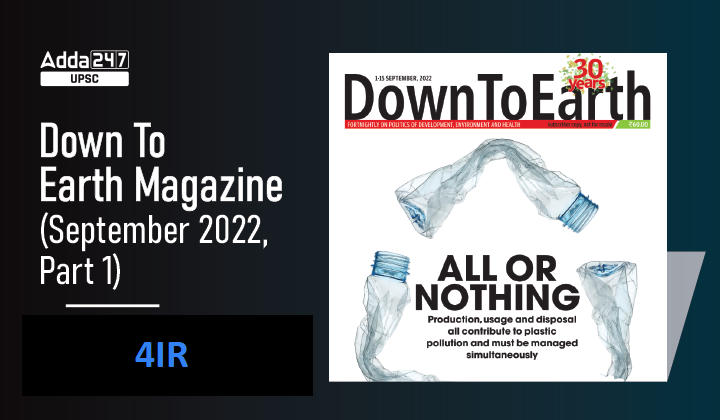Table of Contents
Down To Earth Magazine is a fortnightly magazine focusing on politics of environment and development, published in New Delhi, India.
UPSC Previous years’ questions on Development, Environment, Health and Disaster Management give us a clear idea about the increased importance of Down To Earth Magazine.
Down To Earth Magazine is one of the most important and indispensable sources for UPSC Civil Services Exam Preparation.
Keeping this in mind, here, we come with ”Gist Of Down To Earth Magazine” which covers important environmental current affairs articles in smooth pointed form, keeping in mind the demand of UPSC aspirants.
Introduction
- 4IR is the use of different technologies to blur the boundaries between the digital, physical and biological worlds.
- There are several innovations taking place in the fields of agriculture, manufacturing, mobility (autonomous vehicles), retail stores and almost the entire services industry.
- Such inventions, which often seem like science fiction becoming reality, are what make the ongoing 4IR different from the earlier three industrial revolutions.
- India and most countries are hugely investing in 4IR technologies.
What is 4IR?
- The ability to capture, store, disseminate and model data is fuelling the current revolution and most of the technologies associated with 4IR revolve around the application of data.
- According to management firm Boston Consulting, 4IR is a collection of nine technologies: cloud computing, big data, augmented reality, system integration, autonomous robots, cybersecurity, simulation, additive manufacturing, and the internet of things (IoT).
Who coined the term 4IR?
- The term 4IR was coined by Klaus Schwab, executive chairperson of the World Economic Forum (WEF), in 2016 when he described it as an industrial revolution that “does not change what we are doing but changes us”.
- Ever since the concept has divided the world over its utility and its impact on our future.
What are Xenobots?
- The Xenobots are a near-perfect example of the ongoing fourth industrial revolution (4IR).
- Xenobots, which are less than a milli – metre long, were created in 2020 from the stem cells of the African clawed frog and can be programmed using artificial intelligence.
- When the researchers put the xenobots into a petri dish, they were able to gather hundreds of tiny stem cells inside their mouths and create new xenobots a few days later.
- Once perfected, xenobots could be useful for tasks like cleaning up microplastics and regrowing or replacing dead cells and tissues inside human bodies.
What makes the ongoing 4IR different from the earlier three industrial revolutions?
- The first industrial revolution used water and steam power to mechanise production (the 1800s).
- The second used electric power to create mass production (the early 1900s).
- The third used electronics and information technology to automate production (the late 1900s).
- The 4IR, which is building on the third revolution, has data at its core.
How India is seeing 4IR?
The above examples prove that the urgency around embracing 4IR technologies is visible in India:
Smart Railway Coaches
- In November 2020, the Modern Coach Factory (MCF) at Raebareli, Uttar Pradesh, rolled out smart railway coaches that are fitted with a battery of sensors to provide a comfortable experience to passengers. The sensors monitor odour levels in toilets, check if the doors are safely closed, avoid fire outbreaks and stop unauthorised travel using CCTV cameras with face recognition capabilities, among other technologies.
SAMARTH Scheme
- In May 2020, the Union Ministry of Heavy Industries launched the Smart Advanced Manufacturing and Rapid Transformation Hub (Samarth) scheme, which brings together manufacturers, vendors, and customers to make them aware of 4IR technologies.
Emphasis on 4IR in Budget
- In this year’s budget speech FM announced a slew of new 4IR-driven projects, including Drone Shakti, to encourage start-ups that will facilitate the use of drone services(drones can be utilised in land surveying, spraying insecticides and digitisation of land records), In the field of education, the desh Stack ecosystem would be announced for skilling, re-skilling, and upskilling through online training. The proposed ecosystem will use blockchain technology to make the process of skill acquisition transparent and efficient.
4IR Centre
- India even has a 4IR centre in Mumbai run by WEF, which is closely working with several state governments. The Centre has recently come up with the Fourth Industrial Revolution for Sustainable Transformation (FIRST) Cancer Care model in which 4IR technologies would be used to provide better healthcare for cancer patients.
Digital Twin Technology
- India is also exploring digital twin technology for creating models. A digital twin means creating a highly complex virtual model that is the exact counterpart (or twin) of a physical thing, which can be anything from a car, building or even a person.
Pan India 3D Maps
- On February 19, the Union minister of state for science and technology, Jitendra Singh, launched the pan India 3D maps programme by Genesys International for the 100 smart cities.
- The company plans to map an entire city in intricate detail so that many 4IR revolution technology-based projects, such as driverless cars, will become easier to implement. It is the first step towards completely connected living as envisioned under 4IR.



 TSPSC Group 1 Question Paper 2024, Downl...
TSPSC Group 1 Question Paper 2024, Downl...
 TSPSC Group 1 Answer key 2024 Out, Downl...
TSPSC Group 1 Answer key 2024 Out, Downl...
 UPSC Prelims 2024 Question Paper, Downlo...
UPSC Prelims 2024 Question Paper, Downlo...
